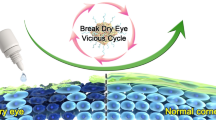Abstract
Purpose
KH902, a recombinant fusion protein, is designed for treatment of neovascular age-related macular degeneration. The study is to investigate the prevention efficacy of KH902 on experimental choroidal neovascularization (CNV) in a monkey model.
Materials and Methods
Binding assay and endothelial cell proliferation assay were used to evaluate activity and bioactivity of KH902 in vitro while an initial comparison of bioactivity was made between KH902 and Ranizumab (Lucentis). Ocular and systemic levels of KH902 were analyzed by enzyme-linked immunosorbent assay (ELISA) method after single intravitreal administration to evaluate its availability to ocular fundus. In vivo pharmacological study, CNV was induced by laser in monkeys and KH902 prevention efficacy on CNV was evaluated by incidence of CNV and several ophthalmic examinations.
Results
KH902 is a unique fusion protein with high affinity to VEGF and good availability to target tissue, beneficial to good bioactivity in vivo. In vivo pharmacological study, the incidence of CNV formation was largely reduced in KH902 treatment groups. Furthermore, the leakage of CNV in control group which crossed over to KH902 treatment 40 days after laser was much less than that before KH902 treatment.
Conclusion
KH902 was effective to prevent the formation of experimental CNV and also to treat pre-existed CNV without evidence of toxicity. This study suggests that KH902 has promise as a local anti-angiogenic treatment of CNV-related diseases.





Similar content being viewed by others
Abbreviations
- AMD:
-
age-related macular degeneration
- CNV:
-
choroidal neovascularization; HUVEC
- OCT:
-
optical coherent tomography
- VEGF:
-
vascular endothelial growth factor
- HUVEC:
-
human umbilical vein endothelial cell
References
D. S. Friedman, B. J. O’Colmain, B. Muñoz, et al. Prevalence of age-related macular degeneration in the United States. Arch. Ophthalmol. 122:564–572 (2004). doi:10.1001/archopht.122.7.1019.
Age-Related Eye Disease Study Research Group. Potential public health impact of age-related Eye Disease Study results: AREDS report. Arch. Ophthalmol. 121(11):1621–1624 (2003). doi:10.1001/archopht.121.11.1621.
H. M. Leibowitz, C. E. Krueger, L. R. Maunder, et al. The Framingham Eye Study monograph: an ophthalmological and epidemiological study of cataract, glaucoma, diabetic retinopathy, macular degeneration, and visual acuity in the general population of 2631 adults, 1973–1975. Surv. Ophthalmol. 24(suppl.):335–610 (1980). doi:10.1016/0039-6257(80)90015-6.
A. Otani, H. Takagi, H. Oh, S. Koyama, Y. Ogura, M. Matumura, and Y. Honda. Vascular endothelial growth factor family and receptor expression in human choroidal neovascular membranes. Microvasc. Res. 64:162–169 (2002). doi:10.1006/mvre.2002.2407.
J. Bainbridge, A. Mistry, M. D. Alwis, E. Paleolog, A. Baker, A. J. Thrasher, and R. R. Ali. Inhibition of retinal neovascularization by gene transfer of soluble VEGF receptor sFlt-1. Gene Ther. 9:320–326 (2002). doi:10.1038/sj.gt.3301680.
M. Zhang, J. Zhang, M. Yan, et al. Recombinant anti-vascular endothelial growth factor fusion protein efficiently suppresses choridal neovasularization in monkeys. Molec. Vis. 14:37–49 (2008).
M. G. Krzystolik, M. A. Afshari, A. P. Adamis, J. Gaudreault, E. S. Gragoudas, N. A. Michaud, W. J. Li, E. Connolly, C. A. O’Neill, and J. W. Miller. Prevention of experimental choroidal neovascularization with intravitreal anti-vascular endothelial growth factor antibody fragment. Arch. Ophthalmol. 120:338–346 (2002).
D. R. Senger, S. j. Galli, A. M. Dvorak, et al. Tumor cells secrete a vascular permeability factor that promotes accumulation of ascites fluid. Science. 219:983–985 (1983). doi:10.1126/science.6823562.
D. W. Leung, G. Cachianes, W. J. Kuang, et al. Vascular endothelial growth factor is a secreted angiogenic mitogene. Science. 246:1306–1309 (1989). doi:10.1126/science.2479986.
K. Suto, Y. Yamazaki, T. Morita, and H. Mizuno. Crystal structures of novel vascular endothelial growth factors (VEGF) from snake venoms: insight into selective VEGF binding to kinase insert domain-containing receptor but not to fms-like tyrosine kinase-1. J. Biol. Chem. 80:2126–2131 (2005).
J. C. Luo, S. Yamaguchi, A. Shinkai, K. Shitara, and M. Shibuya. Significant expression of vascular endothelial growth factor/vascular permeability factor in mouse ascites tumors. Cancer Res. 58:2652–2660 (1998).
J. Holash, S. Davis, N. Papadopoulos, et al. VEGF-Trap: A VEGF blocker with potent antitumor effects. Proc. Natl. Acad. Sci. U.S.A. 99(17):11393–11398 (2002). doi:10.1073/pnas.172398299.
D. M. Maurice, and S. Mishima. Ocular pharmacokinetics. In M. Sears (ed.), Pharmacology of the Eye, Springer, Berlin, 1984, pp. 19–116.
J. Gaudreault, D. Fei, J. Rusit, et al. Preclinical pharmacokinetics of ranibizumab(rhufabv2) after a single intravitreal administration. Invest. Ophthalmol. Visual Sci. 46(2):726–733 (2005). doi:10.1167/iovs.04-0601.
Acknowledgements
The authors would like to thank Bin Liu and his colleagues of the National Chengdu Center for Safety Evaluation of Drugs for they provide and administrate the experimental monkeys.
Author information
Authors and Affiliations
Corresponding author
Rights and permissions
About this article
Cite this article
Zhang, M., Yu, D., Yang, C. et al. The Pharmacology Study of a New Recombinant Human VEGF Receptor-Fc Fusion Protein on Experimental Choroidal Neovascularization. Pharm Res 26, 204–210 (2009). https://doi.org/10.1007/s11095-008-9718-9
Received:
Accepted:
Published:
Issue Date:
DOI: https://doi.org/10.1007/s11095-008-9718-9




